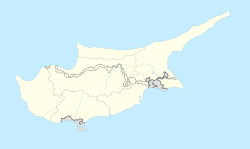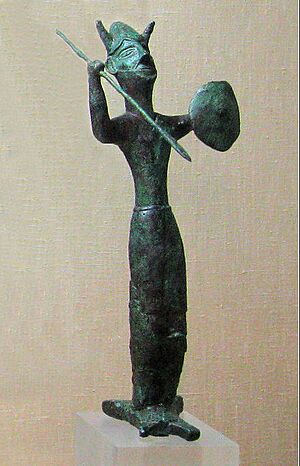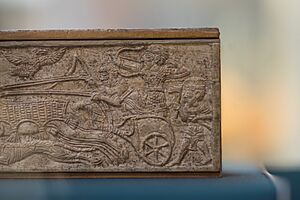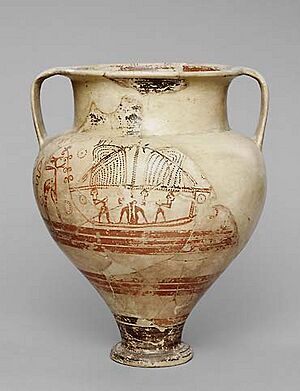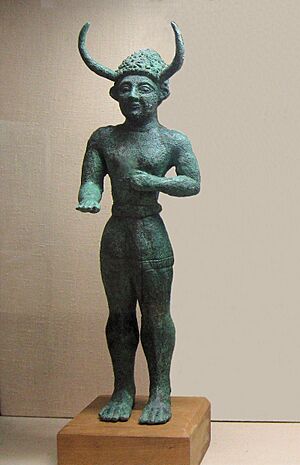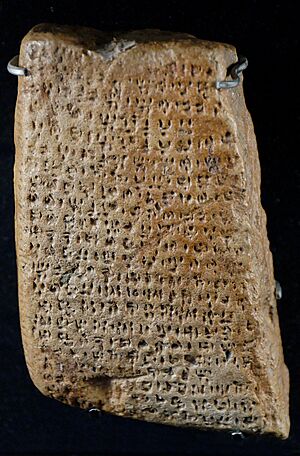Enkomi (archaeological site) facts for kids
| Location | Island of Cyprus |
|---|---|
| Coordinates | 35°9′35″N 33°53′18″E / 35.15972°N 33.88833°E |
| Site notes | |
| Excavation dates | 1895–1898, 1930, 1934, 1958-1973 |
| Archaeologists | Alessandro Palma di Cesnola, A. S. Murray, Einar Gjerstad, Claude F. A. Schaeffer, Porphyrios Dikaios, Oliver Pelon |
| Public access | Yes |
Enkomi (sometimes called Mallia) is an ancient archaeological site on the eastern coast of the island of Cyprus. It was a very important city thousands of years ago, during the Bronze Age. People lived here from about 1900 BC to 1050 BC. Enkomi is famous for its many ancient tombs and amazing metal objects found there. Archaeologists also discovered special writings called Cypro-Minoan Script at this site. Some experts believe Enkomi might have been the ancient city of Alashiya, mentioned in old letters from other parts of the ancient world.
Contents
A Glimpse into Enkomi's Past
Enkomi began as a small settlement during the Middle Bronze Age, around 1900 BC. It was located near a sea inlet, which is now filled with sand and soil. This location was perfect for trade.
Enkomi: A Hub for Copper Trade
From about 1600 BC to 1200 BC, Enkomi grew into a very important trading center. Its main business was copper. People at Enkomi would melt copper ore right there at the site. They traded this valuable metal with other ancient cities, especially Ugarit in what is now Syria. This trade brought wealth and new ideas to Enkomi.
Periods of Growth and Change
Archaeologists study different layers of soil and ruins to understand a site's history. At Enkomi, they found evidence of several important periods:
- Early Days (around 1900-1700 BC): This was the first period of settlement. After this, the site was empty for a while.
- Late Bronze Age Begins (around 1550-1400 BC): Enkomi slowly started to grow again. This period ended with a big earthquake around 1400 BC, which caused a lot of damage.
- Golden Age (14th and 13th centuries BC): Enkomi became a large and busy city. It expanded greatly during these centuries. However, this period also ended with a major destruction around 1220 BC.
- New Settlers and Final Years (1200-1050 BC): After the destruction, new people, possibly from Mycenaean Greece, settled in Enkomi. The city faced another attack around 1125 BC. Eventually, the population slowly decreased, and Enkomi was abandoned around 1050 BC.
Discovering Enkomi: Archaeological Finds
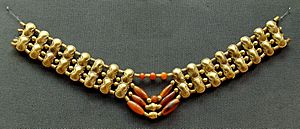
Archaeologists have been studying Enkomi for a long time. Early on, some people dug for treasures without permission, which damaged parts of the site. This led professional archaeologists to start proper excavations.
Early Digs and Important Discoveries
In the late 1800s, A. S. Murray from the British Museum led some of the first major digs. They found many tombs, which are ancient burial places. Inside these tombs, archaeologists discovered amazing items like gold, silver, and ivory objects. These items give us clues about how people lived and what they valued.
Later, in 1930, a team from the Swedish Cyprus Expedition also explored the tombs. They found human remains with beautiful jewelry, like gold pins and headbands. They also found pottery and bronze containers that once held food and drinks for the afterlife.
One archaeologist, Einar Gjerstad, later realized that some of their early digging methods accidentally damaged parts of the ancient city. He said, "I made the worst kind of mistake a scholar can make: I was working on a pre-conceived idea." This shows how archaeologists learn and improve their methods over time.
Protecting the City: The Cyclopean Wall
From 1948 to 1973, French and Cypriot teams worked together at Enkomi. They discovered that the city was once protected by a massive wall. This wall, called a Cyclopean wall, was built with huge stone slabs, some as long as 3.5 meters! It surrounded an area of about 2.5 hectares, protecting the city's inhabitants.
Amazing Metalwork from Enkomi
Enkomi was a major center for working with metals, especially copper. Archaeologists found many workshops, raw materials, and finished metal products. Among the most exciting finds were two unique bronze statues:
- The Ingot God: This statue shows a god wearing a horned hat and armor, holding a shield and spear. He stands on a small, hide-shaped copper ingot, which was a common way to transport copper in ancient times.
- The Horned God: This statue is about half a meter tall. It was found in a large building that might have been used for special ceremonies. Near where the statue stood, archaeologists found many animal bones and gold ornaments, suggesting important rituals took place there.
Archaeologists also found a decorated metal cup, known as the "Enkomi Cup." There's been a long discussion about whether its decoration uses a special technique called niello, which would make it one of the earliest examples of this art.
Exploring Ancient Tombs
Enkomi is believed to have had around 2000 tombs. Most of the archaeological work has focused on these burial sites within the settlement. Many different teams have excavated tombs over the years, finding various types, including chamber tombs and a unique tholos tomb. These tombs provide valuable insights into the burial customs and beliefs of the people of Enkomi.
Unraveling Ancient Writings: Cypro-Minoan Script
One of the most fascinating discoveries at Enkomi is the Cypro-Minoan Script. This is an ancient writing system used in Cyprus during the Late Bronze Age.
Mysterious Messages on Clay
Archaeologists found a small clay cylinder at Enkomi in 1967. It dates back to the 14th century BC. This cylinder has 27 lines of text with 217 signs, making it the longest Cypro-Minoan text found outside of Syria!
Several clay tablets with Cypro-Minoan writing have also been discovered. Three are in the Cyprus Museum, and one is in the Louvre Museum in Paris. These tablets and the cylinder are very important because they show us how people communicated in ancient Enkomi.
Still a Puzzle to Solve
The exciting part is that the Cypro-Minoan Script has not yet been fully translated. We don't know for sure what language it represents. This means that these ancient writings from Enkomi are still a mystery waiting to be solved by future archaeologists and linguists!
Short inscriptions have also been found on pieces of pottery and a small clay ball. Each new discovery helps experts try to piece together this ancient puzzle.
See also
- Cities of the ancient Near East
- Hala Sultan Tekke
- Kourion
- Kition
- Idalium


